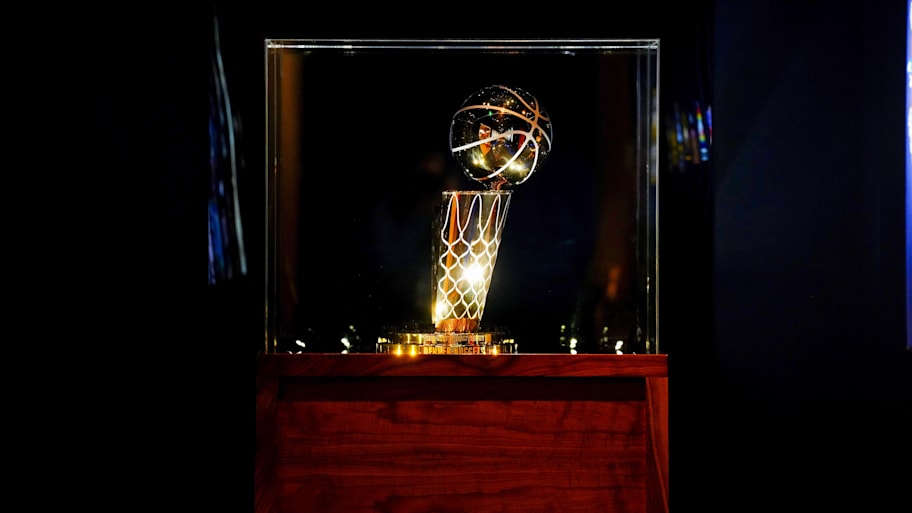
Lawrence Francis O'Brien Jr., better known as Larry O'Brien, is the namesake of the most prestigious trophy in the NBA. However, O'Brien never played a meaningful game of basketball in his life.
So why is the NBA championship trophy named the Larry O'Brien Trophy?
Let's break it down.
O'Brien was born on July 7, 1917 in Springfield, Massachusetts—the city that's referred to as the birthplace of basketball. The son of Irish immigrants, O'Brien had humble beginnings but developed an interest in and appreciation for politics at a relatively young age.
After graduating from the Northeastern University School of Law in 1942 O'Brien began to carve out a career in the Democratic Party.
Before the NBA: Larry O'Brien's Political Career
O'Brien's first major opportunity came when he joined John F. Kennedy's 1952 U.S. Senate campaign, managing field operations. This era served as the foundation for his long relationship with the Kennedy family.
Eight years later, O'Brien would serve as Kennedy's national campaign director. He's credited with playing a crucial role in securing the presidency for JFK. After the inauguration, O'Brien was named Special Assistant to the President. He would often meet with members of Congress and negotiate the Kennedy administration's goals.
O'Brien was in the motorcade on that fateful day in Dallas, when President Kennedy was assassinated in 1963. After that, O'Brien worked for President Lyndon B. Johnson as Director of Legislative Affairs and Postmaster General.
In 1968, when President Johnson declined to seek the Democrat nomination, O'Brien took a job with Senator Robert F. Kennedy as an adviser. After RFK's assassination, O'Brien became the national presidential campaign director for Vice President Hubert Humphrey.
After Humphrey lost the election to Richard Nixon, O'Brien was named the chairman of the DNC. His office was the target of the Watergate break-in.
O'Brien Becomes NBA Commissioner
O'Brien was brought in by the NBA to be commissioner in 1975. At that point, the league was struggling mightily. It wasn't as popular, there was financial instability and the ABA was nipping at the NBA's heels.
With all these struggles afoot, O'Brien's background in high-stakes Washington negotiations and management made him the perfect candidate to get the NBA back on track.
With O'Brien at the helm between 1975 and 1983 the NBA went through a number of transformations, not the least of which being its merger with the ABA in 1976.
Just one year into his tenure, O'Brien led the NBA-ABA merger, which resulted in the San Antonio Spurs, Indiana Pacers, Denver Nuggets and New York Nets joining the league.
O'Brien's NBA Accomplishments
Beyond the merger, O'Brien oversaw a number of other monumental things as NBA commissioner.
The NBA also added an expansion franchise, the Dallas Mavericks. O'Brien orchestrated the then-richest television broadcast deal in the league's history. He also brought the league to cable TV (USA and ESPN).
He worked on the settlement of the Oscar Robertson lawsuit, which led to a new free agency system, introduced the salary cap, modified the NBA draft and oversaw the adoption of the three-point field goal.
The Larry O'Brien Trophy
O'Brien stepped down as commissioner on November 10, 1983, after almost a decade overseeing the NBA. As he stepped down the NBA was on the precipice of entering its golden era, with the Boston Celtics and 'Showtime' Los Angeles Lakers dominating the rest of the 1980s and then Michael Jordan and the Chicago Bulls revolutionizing the game in the 1990s.
While only commissioner for eight years, O'Brien navigated a tumultuous time for the league and did so expertly. The NBA was in a bad way in the mid-1970s, only to be doing record numbers for gates, advertising and ratings by the time he stepped down.
As a result, the NBA wasted little time in renaming the Walter A. Brown Trophy in O'Brien's honor.
The Larry O'Brien Trophy stands at two feet tall and weighs about 15 lbs. It is crafted out of sterling silver and covered with a 24-karat hold overlay. The trophy features a regulation-sized basketball at the top and was redesigned by Victor Solomon for the NBA's 75th anniversary in 2021.
In most cases, the team that wins the championship keeps the trophy. There is, however, one exception. In 2017, Tilman Fertitta purchased the Houston Rockets and Leslie Alexander (the man who sold the team) kept the original 1994 and 1995 trophies. As a result, Houston needed to create replicas, which they commissioned after the sale and revealed in 2018.
More NBA on Sports Illustrated
This article was originally published on www.si.com as Who is Larry O'Brien and Why is the NBA Finals Trophy Named After Him?.







